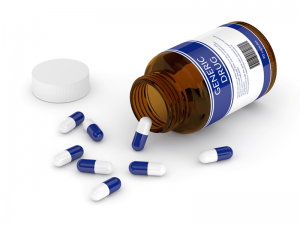Are they really safe and effective? Recent news stories raise questions about these drugs
By Deborah Jeanne Sergeant
 Are generic prescription medications as safe and effective as their name brand counterparts?
Are generic prescription medications as safe and effective as their name brand counterparts?
News reports such as NBC’s “Tainted Drugs” story by Didi Martinez, Brenda Breslauer and Stephanie Gosk aired in May indicate that imported generics may be subpar compared with name brands.
One example was a nationwide recall of generic drug valsartan, a popular blood pressure medication which was found to contain carcinogens. The NBC story stated that about 85% of facilities manufacturing the ingredients used in American drugs come from factories in countries like China and India, where cost is lower, but oversight is not as stringent as in the U.S. or other countries.
Since summer 2018, manufacturers have sent out about 45 recalls of generic blood pressure drugs, including losartan and irbesartan. Their ingredients have been sourced from imported ingredients, according to the NBC story.
In India and China, local laws make it more difficult to inspect. In some cases, manufacturers demand advanced warning before inspections, which in effect negates the point of “surprise” inspections.
Area pharmacists want to reassure patients on the safety and efficacy of their prescriptions.
David Nebbin, pharmacist at Pine Hill Hometown Pharmacy in Cato, said that as a rule, generics are supposed to contain the same active ingredients as the name brand medication.
“The majority of the drugs out there are safe and effective compared with brand name,” Nebbin said. “There’s guidelines they have to follow that they have to fall within a certain level range to be found effective. The brand names have their own issues.”
Nebbin believes that the recent discoveries and recalls of medication indicate that the FDA is doing their job, but he has one caveat.
“They’re finding things after the fact,” Nebbin said. “Sourcing of the ingredients is a big concern, including for the FDA and the policymakers that put these policies in place. They’ve let things go and they’re starting to do more inspections.”
James Della Rocco, director of pharmacy systems for Unity Health in Rochester, isn’t worried about U.S.-sourced medications’ safety. He said that the binders and other inactive ingredients may affect how the drug acts for certain patients, such as not dissolving in the same way. But the low cost of generic drugs makes medication obtainable for many people who would not otherwise be capable of affording their prescriptions, he said.
“If you have concerns about where a drug comes from, ask a pharmacist,” he said. “They can say if it comes from the U.S.”
The Food and Drug Administration inspects medication production plants every two years, but with foreign plants, “they’re not monitored the same as the plants in the U.S.,” Della Rocco said. “Maybe 50 to 100 are inspected and they need to inspect maybe 700. Oftentimes, you have to notify plants in places like China if you’re going to inspect them. These are points of trade agreements we have to look at.”
In the case of carcinogens in the generic drug, valsartan, Della Rocco said that patients would have to consume vast quantities of the medication to “get to the point where you’d get cancer.”
Yet he is concerned about medicinal safety because imported medication isn’t as highly regulated as domestically produced medication.
“We have got to make sure everything that comes into this country is inspected and is safe,” he said. “If you hear about less oversight and that it’s going to be de-regulated, I’d be concerned. You’ve got to be vigilant about what you take and where it comes from.”
At The Medicine Place in Fulton and Phoenix, Zach Merry, head pharmacist, said some customers are asking about their prescriptions.
“Hopefully they sort it all out,” Merry said. “It’s been a frustrating six months since this came to light. All the time, people ask about it. We haven’t had any that are affected. We have definitely been getting questions.”
As for the differences between generics and brand names, “no, there’s no differences,” he said. “It’s regulated by the FDA to be within a certain percentile to be within the same levels of safety and efficacy.”
But he added that the larger percentage of many drugs’ ingredients come from other countries. Despite this, they still have to meet the FDA’s standards.
“We get updates from our wholesalers about recalls,” Merry said. “Any pharmacy keeps a documented list of what they send you to keep an eye out for recalls and any problems.”
Patients can also ask about their medication if they have any concerns about recalls, safety or efficacy.

